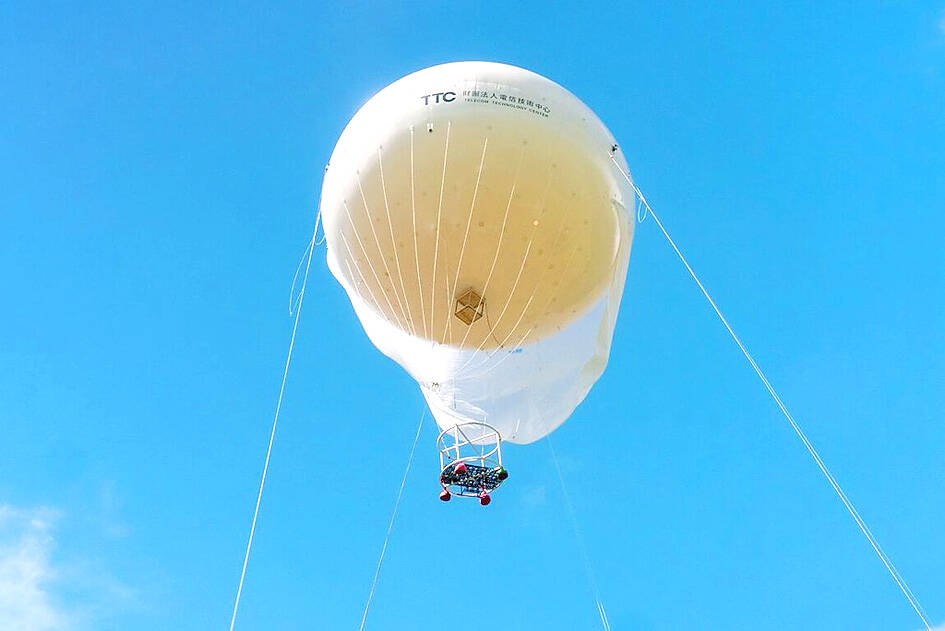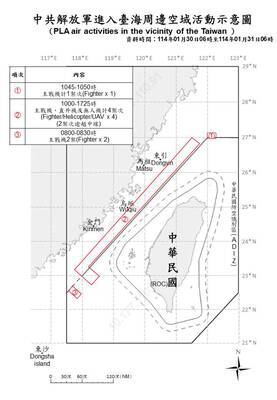The Ministry of Digital Affairs (MODA) yesterday unveiled Taiwan’s first domestically produced tethered high-altitude balloon, which can be used to restore communications in emergencies.
The high-altitude platform has the potential to quickly help restore communications after a disaster, boosting Taiwan’s network resilience, the ministry said.
At an unveiling ceremony at Taitung County’s Luye Highlands (鹿野高台), Minister of Digital Affairs Huang Yen-nun (黃彥男) said that high-altitude balloons are one of the viable solutions to build resilience in network communications, as Taiwan is faced with many natural disasters.

Photo: Liu Jen-wei, Taipei Times
Huang described the efforts as the “pride of Taiwan,” as the technology itself was developed totally in-house.
Telecom Technology Center chief executive officer Lin Hui-tang (林輝堂), who was also at the event, said the balloon can reach an altitude of 800m and provide network coverage across 380km2.
The project is a joint collaboration between the government-sponsored Industrial Technology Research Institute, National Taiwan University of Science and Technology and National Taipei University of Technology, Lin said.

Photo courtesy of Ministry of Digital Affairs
The Taiwan-developed balloon can stay airborne for more than 14 days and is powered by hydrogen fuel cells for stable, low-pollution operation, the ministry said.
It has a load capacity of 50kg and can be equipped with mobile base stations and power equipment to support post-disaster communication and improve coverage in remote areas, the ministry said.
There are three types of high-altitude communication platforms: drones, tethered helium balloons and high-altitude airships, the center said.
The balloon technology is already relatively mature, the center said, citing the platform’s huge payload and the fact that it can stay in the air for longer.
Related projects are also being carried out in Japan, the Czech Republic, the US and the UK, it said.
As the technology matures further, Taiwan-developed balloons could be used to improve network coverage, and support rescue teams and stranded people with reliable messaging, calls and video streaming during post-disaster scenarios, it said.

UNITED: The premier said Trump’s tariff comments provided a great opportunity for the private and public sectors to come together to maintain the nation’s chip advantage The government is considering ways to assist the nation’s semiconductor industry or hosting collaborative projects with the private sector after US President Donald Trump threatened to impose a 100 percent tariff on chips exported to the US, Premier Cho Jung-tai (卓榮泰) said yesterday. Trump on Monday told Republican members of the US Congress about plans to impose sweeping tariffs on semiconductors, steel, aluminum, copper and pharmaceuticals “in the very near future.” “It’s time for the United States to return to the system that made us richer and more powerful than ever before,” Trump said at the Republican Issues Conference in Miami, Florida. “They

GOLDEN OPPORTUNITY: Taiwan must capitalize on the shock waves DeepSeek has sent through US markets to show it is a tech partner of Washington, a researcher said China’s reported breakthrough in artificial intelligence (AI) would prompt the US to seek a stronger alliance with Taiwan and Japan to secure its technological superiority, a Taiwanese researcher said yesterday. The launch of low-cost AI model DeepSeek (深度求索) on Monday sent US tech stocks tumbling, with chipmaker Nvidia Corp losing 16 percent of its value and the NASDAQ falling 612.46 points, or 3.07 percent, to close at 19,341.84 points. On the same day, the Philadelphia Stock Exchange Semiconductor Sector index dropped 488.7 points, or 9.15 percent, to close at 4,853.24 points. The launch of the Chinese chatbot proves that a competitor can

TAIWAN DEFENSE: The initiative would involve integrating various systems in a fast-paced manner through the use of common software to obstruct a Chinese invasion The first tranche of the US Navy’s “Replicator” initiative aimed at obstructing a Chinese invasion of Taiwan would be ready by August, a US Naval Institute (USNI) News report on Tuesday said. The initiative is part of a larger defense strategy for Taiwan, and would involve launching thousands of uncrewed submarines, surface vessels and aerial vehicles around Taiwan to buy the nation and its partners time to assemble a response. The plan was first made public by the Washington Post in June last year, when it cited comments by US Indo-Pacific Commander Admiral Samuel Paparo on the sidelines of the Shangri-La Dialogue

MARITIME SECURITY: Of the 52 vessels, 15 were rated a ‘threat’ for various reasons, including the amount of time they spent loitering near subsea cables, the CGA said Taiwan has identified 52 “suspicious” Chinese-owned ships flying flags of convenience that require close monitoring if detected near the nation, the Coast Guard Administration (CGA) said yesterday, as the nation seeks to protect its subsea telecoms cables. The stricter regime comes after a Cameroon-flagged vessel was briefly detained by the CGA earlier this month on suspicion of damaging an international cable northeast of Taiwan. The vessel is owned by a Hong Kong-registered company with a Chinese address given for its only listed director, the CGA said previously. Taiwan fears China could sever its communication links as part of an attempt